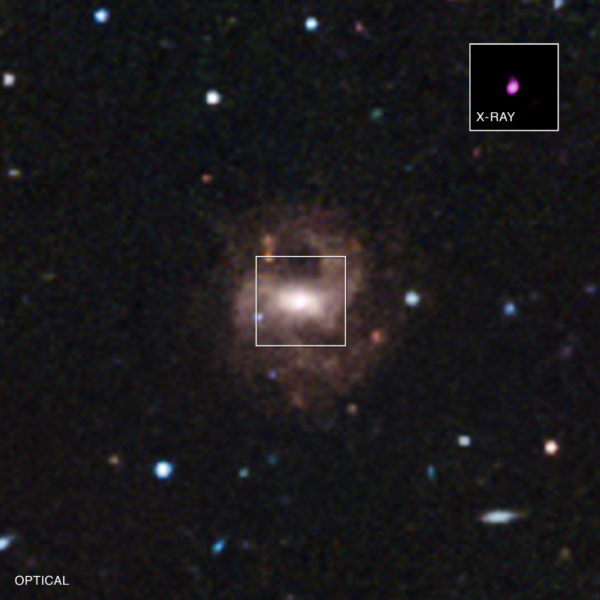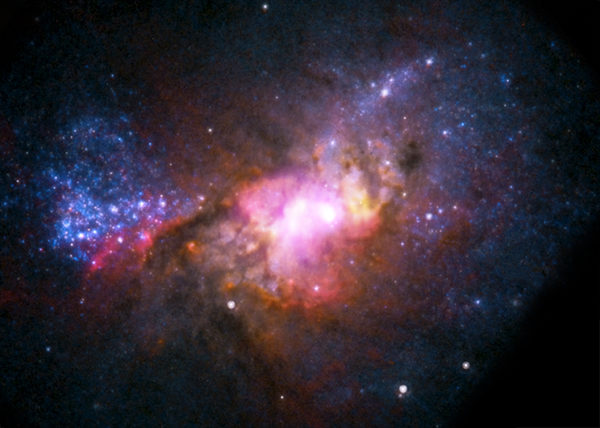"For something to collapse, not all systems have to shut down. In most cases, just one system is enough." -Robert Kiyosaki
Do supermassive black holes form from the merger and growth of many smaller black holes, falling towards a cluster/galactic center where they find one another and grow into a behemoth? Or is there a direct-collapse mechanism at play, where a black hole thousands, tens of thousands or even hundreds of thousands of times the mass of our Sun forms spontaneously?
 The X-ray and optical images of a small galaxy containing a black hole many tens of thousands of times the mass of our Sun. These black holes may have arisen first in the Universe by the direct collapse of matter. Image credit: X-ray: NASA/CXC/Univ of Michigan/V.F.Baldassare, et al; Optical: SDSS; Illustration: NASA/CXC/M.Weiss.
The X-ray and optical images of a small galaxy containing a black hole many tens of thousands of times the mass of our Sun. These black holes may have arisen first in the Universe by the direct collapse of matter. Image credit: X-ray: NASA/CXC/Univ of Michigan/V.F.Baldassare, et al; Optical: SDSS; Illustration: NASA/CXC/M.Weiss.
Until recently, this direct-collapse black hole scenario was thought to leave no observational signatures, but a pristine population of stars, discovered last year, shows a fast-moving offset between hydrogen and helium emissions and an ionization front over 50,000 light years across.
- Log in to post comments


“… there are ultra-massive black holes that have been around as far back as we can see.”
That does seem to be a problem.
...................
“The way we’ll be able to determine whether there truly is a massive black hole will be observational, and it will involve looking for the characteristic radio emissions from black holes.”
Radio emissions from black holes?
I thought nothing escaped from black holes.
@Deceiver #1: "I thought". That word doesn't mean what you think it means. Repeating the same stupidity over and over doesn't make it true. It just demonstrates your deliberately cultivated ignorance and desire to propagate lies.
Well done Michael!
This is starting to look like the ending of each Benny Hill episode, were they're always chasing him because he's trolling …
I can't wait for Dean, Narad and Eric to join the chase …
https://youtu.be/D9I4nZx8UCs
… and I can't wait for the next post to see it happen all over again and again.
Here's an interesting article on how you keep feeding his pride, by continously engaging:
http://motherboard.vice.com/read/french-media-stopped-publishing-terror…
There is a lesson to be learned and it is simple:
Don't feed the troll, move past him and focus on what matters.
“Troll” report through #4:
Posts by See Noevo = 1.
Posts *about* See Noevo = 3.
Answers to See Noevo’s question = 0.
*splorf*
@Ethan wrote
How do we know ultra-massive black holes don't predate stars? I had thought the theory behind direct collapse black holes is they formed at a time when the universe was so hot the cloud fragmentation necessary for star formation wasn't possible.
It was that concept that held up Direct Collapse Black Holes as the solution the Quasar Seed Problem. Star formation wasn't possible, so it collapsed straight to a black hole leaving a bunch of material in the neighborhood that would have otherwise been blown away by if stars had formed.
If that is how it worked the black hole would predate stars. You seem very certain about which came first. Do I have the theory wrong?
@Denier #7: Your understanding is the same as mine, so I hope that Ethan will follow up (either here, or probably in COTW).
It's possible to read his text as meaning the SMBH's we've _observed_ don't predate the first stars (basically, because we aren't looking back far enough to see the first stars, let alone anything before them :-/). But that isn't the most obvious interpretation.
"How do we know ultra-massive black holes don’t predate stars? "
BEcause they would have to collapse to form a black hole and, at some time during that collapse, would start nuclear fusion in the atmosphere.
Moreover, why would there be only enough matter dense enough to collapse ONLY to ultra-massive BHs but none small enough to collapse to incandescent stars???
You're making an argument for the mere sake of arguing.
Could dark matter have contributed to direct collapse?
Not much, since it won't coalesce, therefore it can't increase its effect. Original variation is mostly what you have, and that can, but there's no real reason for it to be more clumped than baryonic matter.